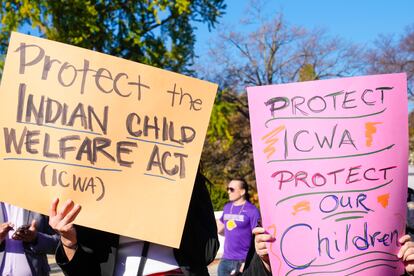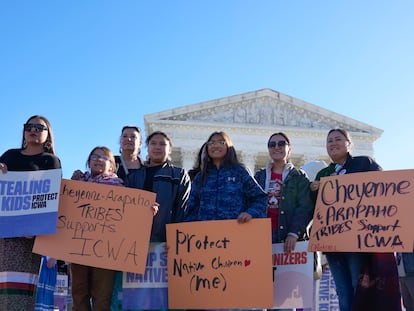Things to know about the Supreme Court ruling upholding the Indian Child Welfare Act
What law says and does, and the reactions of tribal leaders and the law’s opponents are among the things to know after the Supreme Court’s 7-2 decision Thursday upholding the law

The Supreme Court has preserved a federal law giving preference to Native American families when it comes to adopting Native children in foster care. The court’s 7-2 ruling Thursday leaves in place the 1978 Indian Child Welfare Act, which aims to reverse centuries of government-sanctioned efforts to weaken tribal identity by separating Native American children from their families and raising them outside their tribal cultures.
Here are some things to know about the law and the issues around it:
What was the purpose of the 1978 Indian Child Welfare Act?
The law requires states to notify tribes when adoption cases involve their members or children eligible for tribal membership, and to try to place them with their extended family, their tribe or other Native American families. It was enacted to address historic injustices: Before the law took effect, between 25% and 35% of Native American children were being taken from their families and placed with adoptive families, in foster care or in institutions. The majority were placed with white families or in boarding schools in attempts to assimilate them. A series of scandals involving the long-closed boarding schools shed light on government-sanctioned efforts to wipe out Native culture by cutting their hair and forbidding them from speaking their languages.
How are tribal leaders reacting?
Native American leaders are celebrating the ruling as a huge win. A joint statement by Cherokee Nation Principal Chief Chuck Hoskin, Jr., Morongo Band of Mission Indians Chairman Charles Martin, Oneida Nation Chairman Tehassi Hill and Quinault Indian Nation President Guy Capoeman said they hope it will “lay to rest the political attacks aimed at diminishing tribal sovereignty.” Navajo Nation President Buu Nygren called it a victory for “all Indigenous children and all Indigenous Nations in the United States.” The Native American Rights Fund said 497 tribal nations, 62 Native organizations, 23 states, 87 members of Congress and 27 child welfare and adoption organizations signed onto Supreme Court briefs supporting the law.
What does this mean for the relationship between tribes and the U.S?
Justice Neal Gorsuch set the ruling in the context of a sweeping history of the relationship between tribal nations and state and federal governments, noting that past Supreme Court rulings at times were confusing or contradictory. “Often, Native American Tribes have come to this Court seeking justice only to leave with bowed heads and empty hands,” Gorush said. “But that is not because this Court has no justice to offer them. Our Constitution reserves for the Tribes a place — an enduring place — in the structure of American life. It promises them sovereignty for as long as they wish to keep it. And it secures that promise by divesting States of authority over Indian affairs and by giving the federal government certain significant (but limited and enumerated) powers aimed at building a lasting peace.”
What was the argument against the act?
Three white families and several Republican-led states including Texas claimed the law is based on race in violation of the equal protection clause and puts the interests of tribes ahead of what’s best for the children. They also argued that the law gives the federal government excessive power over adoptions and foster placements, which are generally overseen by states, and challenged whether Congress even has the authority to pass laws addressing Native American issues. The lead plaintiffs, Chad and Jennifer Brackeen of Fort Worth, Texas, adopted a Native American child after a lengthy battle with the Navajo Nation, one of the two largest tribes in the U.S. The couple wants to adopt the boy’s 5-year-old half-sister, who has lived with them since infancy; the Navajo Nation opposes it. Justices Clarence Thomas and Samuel Alito dissented, with Alito writing that the decision “disserves the rights and interests of these children.”
What happens now?
Justice Brett Kavanaugh cautioned in a separate concurring opinion that the court didn’t address the merits of whether the law provides an unconstitutional racial preference for Native foster and adoptive parents. “In my view, the equal protection issue is serious,” Kavanaugh wrote, and suggested the court should revisit the issue with plaintiffs found to have proper standing in a state court. Attorney Mathew McGill, representing the Brackeens, said he would press just such a claim. McGill runs the gaming practice for the Gibson Dunn law firm and successfully argued Murphy v. NCAA before the Supreme Court, which gave all states the ability to legalize sports betting to the detriment of tribal casinos around the country.
Sign up for our weekly newsletter to get more English-language news coverage from EL PAÍS USA Edition
Tu suscripción se está usando en otro dispositivo
¿Quieres añadir otro usuario a tu suscripción?
Si continúas leyendo en este dispositivo, no se podrá leer en el otro.
FlechaTu suscripción se está usando en otro dispositivo y solo puedes acceder a EL PAÍS desde un dispositivo a la vez.
Si quieres compartir tu cuenta, cambia tu suscripción a la modalidad Premium, así podrás añadir otro usuario. Cada uno accederá con su propia cuenta de email, lo que os permitirá personalizar vuestra experiencia en EL PAÍS.
¿Tienes una suscripción de empresa? Accede aquí para contratar más cuentas.
En el caso de no saber quién está usando tu cuenta, te recomendamos cambiar tu contraseña aquí.
Si decides continuar compartiendo tu cuenta, este mensaje se mostrará en tu dispositivo y en el de la otra persona que está usando tu cuenta de forma indefinida, afectando a tu experiencia de lectura. Puedes consultar aquí los términos y condiciones de la suscripción digital.
More information
Archived In
Últimas noticias
Most viewed
- Sinaloa Cartel war is taking its toll on Los Chapitos
- Oona Chaplin: ‘I told James Cameron that I was living in a treehouse and starting a permaculture project with a friend’
- Reinhard Genzel, Nobel laureate in physics: ‘One-minute videos will never give you the truth’
- Why the price of coffee has skyrocketed: from Brazilian plantations to specialty coffee houses
- Silver prices are going crazy: This is what’s fueling the rally










































